
Freezing Tomatoes
We are about to take off to hiking in the Northwest for a week and so we’re gathering in some more of the harvest before we go. The soups, sauces, and tomato supper dishes were not keeping up with the influx so we’ve taken to freezing the tomatoes. Much like we do with blueberries, the tomatoes are simply cored and spread on a cookie sheet to freeze and then we take those rock solid red tennis balls and put them in plastic bags. Then at some point we will add those tomatoes to tomato-based sauces this winter.
One of the fruits reaching the harvest point right now are the Japanese Pears.
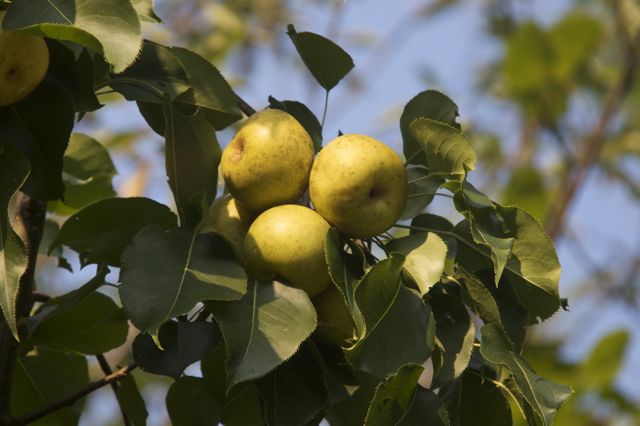
Japanese Pears fully ripe
This a tree we often call Josh’s miracle tree for the spectacular recovery it made from a near death experience. The full story will be told at a later date… Suffice it to say for now that this is a consistent yielder of fully organic, no-need-to-spray fruit. The flavor will never match a good Doyenné du Comice Pear, but you can’t have everything…

The Japanese Pear is a prolific bearer every year
I should have mentioned earlier that the early mums that we get every year are doing their thing and have been out for at least a month. Don’t know why they come so early but we won’t complain.
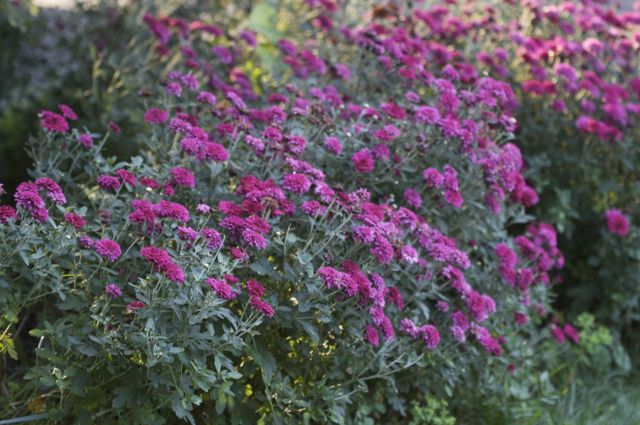
Early blooming Chrysanthemum
This is a good time of the year for butterflies and dragonflies. I noticed one odd looking dragonfly the other day and I now realize that it’s quite common. In fact it’s known as the ‘Common Whitetail’. Nonetheless it is quite distinctive to look at.
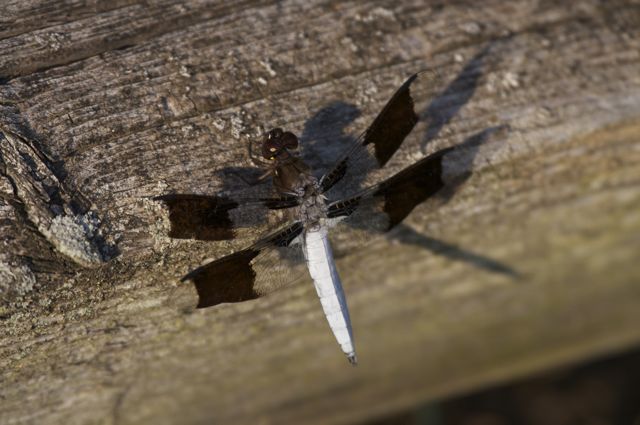
Common Whitetail (Libellula lydia)
We’ve just had two days of rainfall (finally!) but I went out one of the hot dry days before that and dug a new Iris bed.
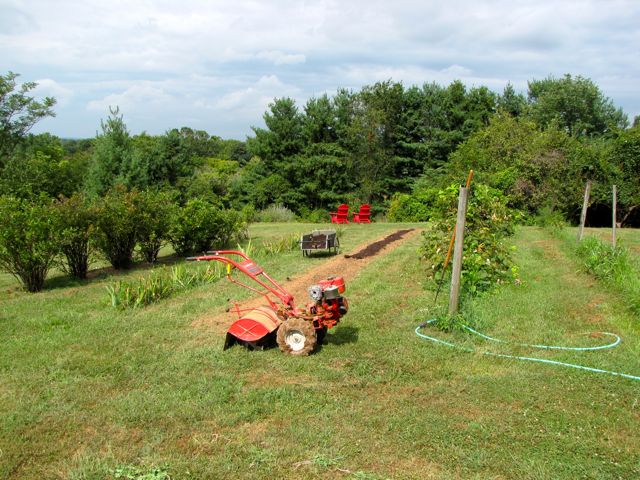
Tilling a new Iris bed
I really went for overkill but who knows what else can go in this sunny spot before we get enough Iris to fill it. At the moment we only have an additional 9 Iris from Schreiners and several from our Boston connection but once I was into digging I had to complete the row. It was very dry but I persisted with the plow attachment on the roto-tiller and then filled the trench with water and repeated the process. I think I could have used the sweat from my drenched tee-shirt to soften the ground as well. I followed by filling the new trench with compost and then doing it all over again. Even with all of that it would probably be good to let the remainder lie fallow and do it again next year but we shall have to see what else needs planting in the interim…
On the bird front we had a cute little visitor the other morning. My guess is a Yellow-Throated Vireo but I’m open to other interpretations.

Yellow-Throated Vireo? (Vireo flavifrons)
And let me close this post with another image of the Northern Sea Oats. The world can simply not have enough of these beautiful plants which look different in every kind of light.

Northern Sea Oats (Chasmanthium latifolium)
A Tomato Fest

The daily picking baskets
I saw a reference to Summer Fest on A Way to Garden and since this was the Tomato week for that celebration I thought it would be good to talk about the tomato harvest here.
Last week we saw the movie Julie & Julia (Great flick!). It certainly sets a high standard for appreciation of food and it’s preparation (though I probably saw more butter than I’ve eaten in my lifetime). We have currently been relishing our own incoming produce and the many minor variations of cooking everything that’s being harvested. It’s mostly tomatoes, peppers, squash, cucumbers, beans, onions, and eggplant. The evening meal is some variation of tomatoes, peppers, squash, onions and eggplant stir fried together in olive oil and balsamic vinegar with garlic and herbs to taste (Beth uses fresh stuff from her herb garden and I tend to grab the dried products off the shelf). For protein we throw in some tofu or chicken meatballs and a little mozzarella cheese. If I’m the one doing the mixing some kind of nuts will be involved (pine nuts, hazelnuts, or walnuts). Every night is slightly different but always delicious. The ritual ends with us lifting the plate to our lips and draining the plate of the last of the luscious tomato-based sauce. Altogether with cutting up this takes two people maybe 15 minutes to prepare and could not be much better.
However, even with this kind of eating we’re not even close to using the produce. Beth cooked up a couple of batches of tomato sauce for the winter this week. This gives her more opportunity to tap into her herb garden. And we’ve been giving stuff away as well. And yet, the refrigerator overfloweth. I feel bad for the folks in the northeast who’ve been hit by blight. We were fortunate that everything was grown from seed and we have had sort of a mixed bag of rainfall — good rain early on and a lot of dry sunny days in July/August — which has had me doing hand watering but it’s been good for the tomatoes and peppers. I don’t think we’ve ever had peppers this nice.

Some big blocky red peppers

Tomatoes are slowing down but many still on the vines
The hot weather has made it less desirable to work in the garden and it is starting to get away from me. But I also know that we are going hiking in the west in a few days so that there is only so much I can do anyway.

Garden is getting overgrown
The Birds of August

Eastern Towhee (Pipilo erythrophthalmus)
At this point the mulberries are long since past and yet I find that I can still visit the mulberry tree in the mornings and commune with the local bird population. It seems that if I sit down there and just wait for the birds to come there is always something going on. The Eastern Towhee was something of a surprise because I’ve only seen them a couple of times before and yet on this morning in early August he stayed around for quite a while. They are reasonably shy birds and don’t seem to venture near the house very often. But their coloring is really unique and you won’t forget it once you have seen one.

Eastern Towhee
On the same day that the Towhee stopped in, the Indigo Bunting made a surprise return. I saw one male at the top of the tree. However since then I think I’ve seen the female so it may be they will stick around…

Indigo Bunting (Passerina cyanea) returns
Just when I was thinking that the Baltimore Orioles must have taken an early trip to the south for their winter vacation, I saw a brilliant male in the Cherry tree.

Baltimore Oriole (Icterus galbula)
When I zoom in on the photo it looks like a Japanese Beetle in his beak which is all the more reason to be happy to see him.
It turns out that one of the really difficult things with taking bird pictures (for me anyway) is getting the action shots of the birds in flight. With a telescopic lens trying to both track and focus on the bird in flight for that brief moment when they are overhead is quite difficult. It’s easiest when you are dealing with slow moving water birds that are just gaining altitude or coming in for a landing. But for many of the birds that I’ve been photographing that ‘bird on the wing’ shot is hard to get. I came close that morning to getting the kind of shots that I’m aiming for.

Baltimore Oriole sequence 1

Baltimore Oriole sequence 2

Baltimore Oriole sequence 3

Baltimore Oriole sequence 4

Baltimore Oriole sequence 5
Sometimes when I look up I see one of the local water birds flying overhead. That was the case with this Black-crowned Night Heron that passed by recently. The elongated head is quite distinctive.

Immature Black-crowned Night Heron (Nycticorax nycticorax)
It seems, however, that my constant companions are the hummingbirds which are there almost every morning I go out to the garden, though I’m not always swift enough to capture them on camera.

Ruby-throated Hummingbird (Archilochus colubris) on Fence
Garden Blogger’s Bloom Day for August

Black-eyed Susans (Rudbeckia hirta)
Well it would be difficult to have a Garden Blogger’s Bloom Day for August without showcasing the Black-eyed Susans. This is Maryland’s state flower and they grow easily and abundantly here — but they grow almost everywhere else too. Wildseed Farms thinks that this is probably the most common of all American wildflowers. What is interesting for this bloom day is that we not only have the Black-eyed Susans but we have a visitor in their midst.
Imagine if you gave a party and a beautiful girl came that neither you nor your wife recognized. But she adds life to the party and after a while you both kind of imagine that you must have invited her at some point. Well that’s they way it is with the Euphorbia that has sprung up in the rock garden. I can sort of imagine that I might have planted it this spring before everything was showing but I don’t have any recollection of having bought it or growing it from seed.
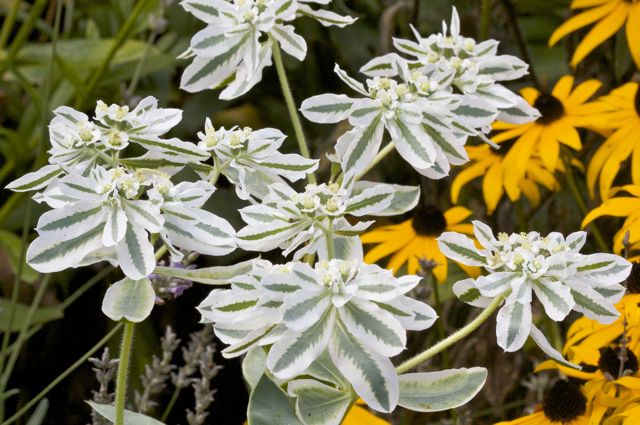
Euphorbia marginata
Jonathan has identified this as a Euphorbia and since I do have a fondness for them I might well have purchased it but I sure can’t remember doing so … or maybe? Anyway it’s a pretty plant and certainly adds a splash of green and white that is kind of out of kilter with the rest of the plants in the rock garden, or maybe I should be more positive and say it really stands out from the crowd.

Euphorbia marginata
I like to kind of go around on bloom day and see what stands out or is new on the scene this week. It is hard to miss the Bougainvillea as you come up our driveway. It’s in a big pot and the color of the bracts makes a noticeable impact on the senses.

Bougainvillea 'Barbara Karst'
This plant is about 25 years old now and winters over in the basement quite well.
Another plant with vibrant flowers right now is the Crepe Myrtle.

Crepe Myrtle (Lagerstroemia Indica)
Ours is a tree that is about 20 feet tall rising above the garage so that we can see the flowers from our deck. Since it has a long period of flower it’s easy to take the beauty of this tree for granted. But I would probably plant it even without the flowers because bark is so incredibly variegated and smooth to the touch.
A recent arrival is an Astilbe that I bought while driving down from Boston on this last trip. I stopped at Oliver Nurseries in Fairfield, Connecticut and managed to limit myself to 5 plants. This is a major accomplishment if you have ever visited them (less than 5 minutes from the I-95).

Astilbe simplicifolia 'Key West'
This is a nice new compact Astilbe with dark foliage and pink plumes on red stems. Though I’ve not been that fond of Astilbes in the past, I think that this variety is about to change my opinion…
We’ve also just seen the first Japanese Anemone coming into flower (though I saw them in Boston two weeks ago — go figure…).

Japanese Anemone (Anemone hupehensis var japonica)
These flowers are almost weed-like in their rugged persistence and long flowering period in the fall. They seem to relish both deep shade and sun/shade locations as well. Our experience is that while they spread easily they don’t force their way onto the turf of other plants and they seem to play nicely with many other plants that have spring flowering in the shade environment, for example azaleas and pieris.
In the garden we have a great many zinnias and cosmos ready for cutting every day or so.

Zinnias and Cosmos in the cutting garden
The zinnias are particularly popular with various butterflies and moths. Note to self — more time to be spent photographing the zinnias and their visitors.
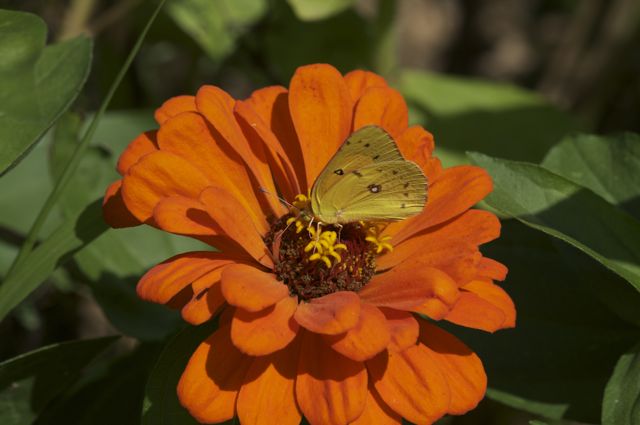
Zinnia and butterfly
Boston and Long Hill
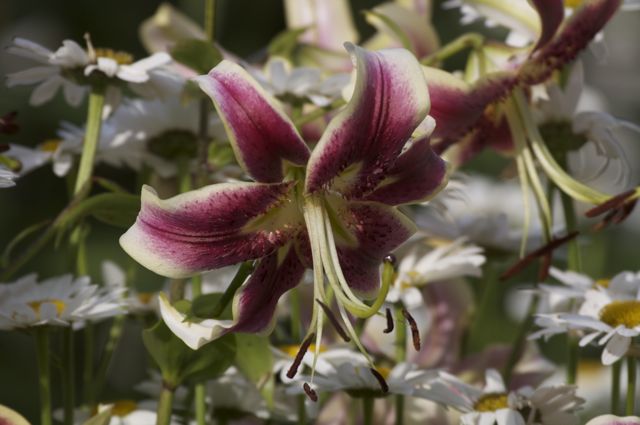
Lily 'Scheherazade', an Oriental Triumph hybrid
Last week we visited our Boston connection (Winchester actually) where in addition to seeing our delightful granddaughter and the two parents she maintains we did some garden maintenance and garden visiting. One of the virtues of traveling north is that you get to experience the season we’ve just finished all over again. And that included some marvelous lilies on display.

Scheherazade lilies in the perennial garden
Despite the lily beetles which seem to be a very real problem in the north, they still managed to get some choice blooms. There were lilies all around the yard just coming into bloom. The most unique from our point of view was the Gloriosa Lily which we still have not managed to get to grow here.
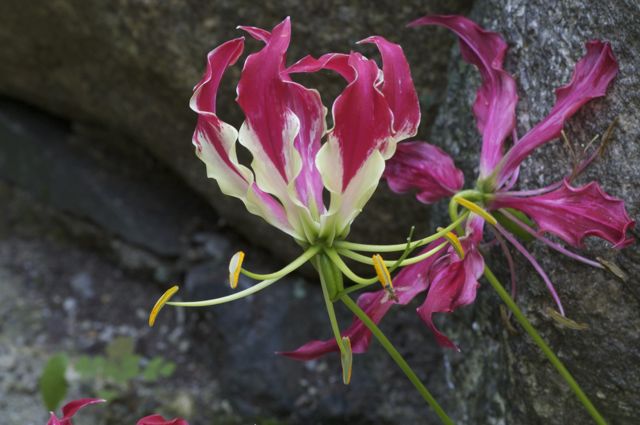
Glory Lily (Gloriosa superba 'Rothschildiana')
This is a sprawling vine-like creature with uniquely beautiful flowers. We didn’t see so much as a green bud from the one we planted. So I think we try planting it in a pot next year.
And they also have a marvelous Mango colored daylily which is a real eye-catcher.

Mango-colored daylily (Hemerocallis)
We took off on an excursion during one of the days we visited and traveled to Long Hill, a property near Beverly, Massachusetts that is run by the Trustees of Reservations in Massachusetts. This turned out to be an exceptionally nice property with extensive perennial and tree plantings that are worth visiting any time of year. The former editor of Atlantic Magazine and two successive wives created a estate setting with a charming mix of wild and cultivated plants. Among the unique finds there was a Mountain Stewartia (also called Mountain Camellia).

Mountain Stewarta (Stewartia ovata)
This distinctive plant of the Appalachian region is related to the Camellias of the far East. I, for one, had never seen it before in any of the plant collections I’ve toured (but maybe I wasn’t looking at the right season). It has beautiful flowers but none of the attractive bark of the other Stewartias I’m familiar with.
It’s about 5 acres of cultivated gardens at Long Hill with several small squarish ponds filled with water lilies. We also found in one of them a frog that was worthy of photographing.

Frog on a lilypad
This very colorful frog is hereby dedicated to Margaret Roach at A Way to Garden and her Frogboy site. It seems so natural to see a relaxed frog in a little pond. Ironically, the stream in the backyard of the kids house in Winchester (close to Boston) has yet to attract a single frog, toad, or minnow. We keep hoping.
The water at Long Hill also attracted a lot of dragonflies and I took a few photos mostly in honor of Randy Emmitt in North Carolina who does such a fine job of photographing insects of all kinds, but especially dragonflies.

Blue Dasher Dragonfly (Pachydiplax longipennis) ID thanks to Randy Emmitt